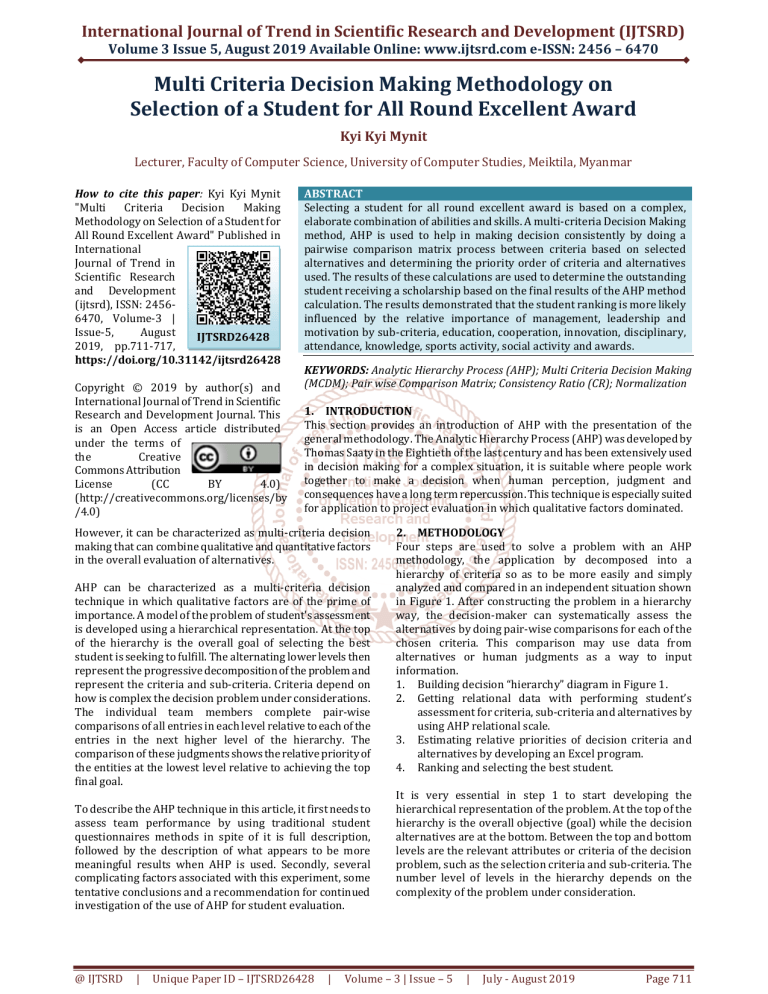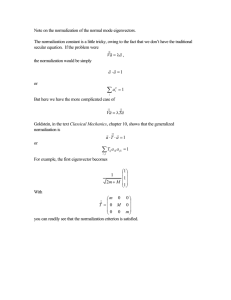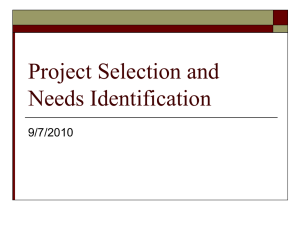
International Journal of Trend in Scientific Research and Development (IJTSRD)
Volume 3 Issue 5, August 2019 Available Online: www.ijtsrd.com e-ISSN: 2456 – 6470
Multi Criteria Decision Making Methodology on
Selection of a Student for All Round Excellent Award
Kyi Kyi Mynit
Lecturer, Faculty of Computer Science, University of Computer Studies, Meiktila, Myanmar
How to cite this paper: Kyi Kyi Mynit
"Multi
Criteria
Decision
Making
Methodology on Selection of a Student for
All Round Excellent Award" Published in
International
Journal of Trend in
Scientific Research
and Development
(ijtsrd), ISSN: 24566470, Volume-3 |
Issue-5,
August
IJTSRD26428
2019, pp.711-717,
https://doi.org/10.31142/ijtsrd26428
Copyright © 2019 by author(s) and
International Journal of Trend in Scientific
Research and Development Journal. This
is an Open Access article distributed
under the terms of
the
Creative
Commons Attribution
License
(CC
BY
4.0)
(http://creativecommons.org/licenses/by
/4.0)
ABSTRACT
Selecting a student for all round excellent award is based on a complex,
elaborate combination of abilities and skills. A multi-criteria Decision Making
method, AHP is used to help in making decision consistently by doing a
pairwise comparison matrix process between criteria based on selected
alternatives and determining the priority order of criteria and alternatives
used. The results of these calculations are used to determine the outstanding
student receiving a scholarship based on the final results of the AHP method
calculation. The results demonstrated that the student ranking is more likely
influenced by the relative importance of management, leadership and
motivation by sub-criteria, education, cooperation, innovation, disciplinary,
attendance, knowledge, sports activity, social activity and awards.
KEYWORDS: Analytic Hierarchy Process (AHP); Multi Criteria Decision Making
(MCDM); Pair wise Comparison Matrix; Consistency Ratio (CR); Normalization
1. INTRODUCTION
This section provides an introduction of AHP with the presentation of the
general methodology. The Analytic Hierarchy Process (AHP) was developed by
Thomas Saaty in the Eightieth of the last century and has been extensively used
in decision making for a complex situation, it is suitable where people work
together to make a decision when human perception, judgment and
consequences have a long term repercussion. This technique is especially suited
for application to project evaluation in which qualitative factors dominated.
However, it can be characterized as multi-criteria decision
making that can combine qualitative and quantitative factors
in the overall evaluation of alternatives.
AHP can be characterized as a multi-criteria decision
technique in which qualitative factors are of the prime of
importance. A model of the problem of student's assessment
is developed using a hierarchical representation. At the top
of the hierarchy is the overall goal of selecting the best
student is seeking to fulfill. The alternating lower levels then
represent the progressive decomposition of the problem and
represent the criteria and sub-criteria. Criteria depend on
how is complex the decision problem under considerations.
The individual team members complete pair-wise
comparisons of all entries in each level relative to each of the
entries in the next higher level of the hierarchy. The
comparison of these judgments shows the relative priority of
the entities at the lowest level relative to achieving the top
final goal.
To describe the AHP technique in this article, it first needs to
assess team performance by using traditional student
questionnaires methods in spite of it is full description,
followed by the description of what appears to be more
meaningful results when AHP is used. Secondly, several
complicating factors associated with this experiment, some
tentative conclusions and a recommendation for continued
investigation of the use of AHP for student evaluation.
@ IJTSRD
|
Unique Paper ID – IJTSRD26428
|
2. METHODOLOGY
Four steps are used to solve a problem with an AHP
methodology, the application by decomposed into a
hierarchy of criteria so as to be more easily and simply
analyzed and compared in an independent situation shown
in Figure 1. After constructing the problem in a hierarchy
way, the decision-maker can systematically assess the
alternatives by doing pair-wise comparisons for each of the
chosen criteria. This comparison may use data from
alternatives or human judgments as a way to input
information.
1. Building decision “hierarchy” diagram in Figure 1.
2. Getting relational data with performing student’s
assessment for criteria, sub-criteria and alternatives by
using AHP relational scale.
3. Estimating relative priorities of decision criteria and
alternatives by developing an Excel program.
4. Ranking and selecting the best student.
It is very essential in step 1 to start developing the
hierarchical representation of the problem. At the top of the
hierarchy is the overall objective (goal) while the decision
alternatives are at the bottom. Between the top and bottom
levels are the relevant attributes or criteria of the decision
problem, such as the selection criteria and sub-criteria. The
number level of levels in the hierarchy depends on the
complexity of the problem under consideration.
Volume – 3 | Issue – 5
|
July - August 2019
Page 711
International Journal of Trend in Scientific Research and Development (IJTSRD) @ www.ijtsrd.com eISSN: 2456-6470
Figure.1: AHP example of approaching goal for
selecting an outstanding student.
Table.1 Numerical relational scale
Intensity of important
Definition
1
Equal importance
3
More importance
5
Much More importance
7
Very Much More strong
9
Extremely More importance
2,4,6,8
Intermediate values
At step 2, we need to gather data to compare the
alternatives. The decision-maker has to make pair-wise
comparisons of criteria at each level relative to each activity
at the next adjacent higher level in the hierarchy. In AHP, a
relational scale of numbers from 1 to 9 is used to
systematically assign preferences. When comparing two
attributes, A and B, with respect to GOAL in a higher level,
the numerical relational scale is used as shown in TABLE I.
alternative is calculated. The probability determines the
likelihood that the alternative has to achieve the expected
goal. The high the probability, the better chances the
alternative has to satisfy the final goal. The priorities (or
weight) of the lowest level alternatives relative to the top
objective are determined and displayed. AHP facilitates a
comprehensive and logical analysis of problems for which
considerable uncertainty exists. In fact, the power of AHP
(and to a large degree is uniqueness) is the ability to
consider qualitative goal and attributes within its
framework. Generally speaking, the mathematical calculation
involved in the AHP may seem simple at first, but if dealing
with a more complex scenario, the calculations become more
complicated.
3. DEVELOPMENT AND RESEARCH OF METHODS FOR
SELECTING THE BEST STUDENT
A. Defining the pairwise comparison matrix of the student
by focusing on sub-criteria Supervisors and the students
work together to get the comparison matrix after
considering the hierarchy structure for achieving the
final goal. The student did of all comparisons for all subcriteria education, cooperation, innovation, disciplinary,
attendance, knowledge, sports activity, social activity
and awards. If the consistency ratio (CR) of their
comparisons were significantly high, supervisors need
to rearrange student's assessment to get the proper CR
[9-11]. Comparison matrix and eigenvector are
presented in TABLE II-IX.
Table.2 Comparison matrix for focusing student’s
education
Education
S1
S2 S3 S4 S5
In step 3, the pair-wise comparison matrix can be created by
using the Eigenvalue method in step 2. These Eigenvalues
can be determined the relative priority of each attribute to
each attribute level up in the hierarchy. The method of
pairwise comparisons is systematic and comprehensive. One
might want to repeat a set of pairwise comparison if the
consistency ratio is alarmingly high. In spite of the decisionmaker has the option of redoing the comparison matrix if
desired to improve the consistency.
In step 4, after all comparisons have been made, and the
relative weights between each one of the criteria to be
evaluated have been found, the numerical probability of each
S1
1
3
6
S2
S3
S4
S5
Sum
1
4
0.3333
1
0.1667
1
0.5
2
2
0.5
2
1
4
0.25
1
1
4
0.25
2.75
0.5
7
1
14
0.25
3
1
12
Table.3 Normalization comparison matrix and eigenvector (CR=0.0059)
Normalization
S1
S2
S3
S4
S5
Eigen Vector
S1
0.3636
0.4286
0.4286
0.3333
0.3333
0.3775
S2
S3
0.1212
0.0606
0.1429
0.0714
0.1429
0.0714
0.1667
0.0833
0.1667
0.0833
0.1481
0.0740
S4
S5
0.3636
0.0909
0.2857
0.0714
0.2857
0.0714
0.3333
0.0833
0.3333
0.0833
0.3203
0.0801
Table.4 Comparison matrix for focusing student’s cooperation
Co-operation S1
S2
S3 S4
S5
@ IJTSRD
|
S1
1
0.5
3
2
0.25
S2
S3
2
0.33
1
0.167
6
1
4
0.5
2
0.2
S4
0.5
0.25
2
1
0.25
S5
Sum
4
7.83
0.5
2.417
5
17
4
11.5
1
3.7
Unique Paper ID – IJTSRD26428
|
Volume – 3 | Issue – 5
|
July - August 2019
Page 712
International Journal of Trend in Scientific Research and Development (IJTSRD) @ www.ijtsrd.com eISSN: 2456-6470
Table.5 Normalization comparison matrix and eigenvector (CR=0.0396)
Normalization
S1
S2
S3
S4
S5
Eigen Vector
S1
0.1277 0.2069 0.1765 0.1739 0.0676
0.1505
S2
0.2553 0.4138 0.3529 0.3478 0.5405
0.3821
S3
0.0426 0.0690 0.0588 0.0435 0.0541
0.0536
S4
0.0638 0.1034 0.1176 0.0870 0.0676
0.0879
S5
0.5106 0.2069 0.2941 0.3478 0.2703
0.3259
Table.6 Comparison matrix for focusing student’s innovation
Innovation
S1 S2
S3
S4 S5
S1
1
4
0.25
0.5
5
S2
0.25 1
0.2
0.25 1
S3
4
5
1
2
6
S4
2
4
0.5
1
5
S5
0.2
1 0.167 0.2
1
Sum
7.45 15 2.117 3.95 18
Table.7 Normalization comparison matrix and eigenvector (CR=0.0404)N
Normalization
S1
S2
S3
S4
S5
Eigen Vector
S1
0.1342 0.2667 0.1181 0.1266 0.2778
0.1847
S2
0.0336 0.0667 0.0945 0.0633 0.0556
0.0627
S3
0.5369 0.3333 0.4724 0.5063 0.3333
0.4365
S4
0.2685 0.2667 0.2362 0.2532 0.2778
0.2605
S5
0.0268 0.0667 0.0787 0.0506 0.0556
0.0557
Table.8 Comparison matrix for focusing student’s disciplinary
Disciplinary
S1
S2
S3 S4 S5
S1
1
0.25
3
0.5
4
S2
4
1
6
2
5
S3
0.333 0.167 1 0.50 1
S4
2
0.5
2
1
4
S5
0.25
0.2
1 0.25 1
Sum
7.583 2.117 13 4.25 15
Table.9 Normalization comparison matrix and eigenvector (CR=0.0412)N
Normalization
S1
S2
S3
S4
S5
Eigen Vector
S1
0.132 0.118 0.231 0.117 0.267
0.1730
S2
0.528 0.472 0.462 0.471 0.333
0.4531
S3
0.044 0.079 0.078 0.118 0.067
0.0768
S4
0.264 0.236 0.154 0.235 0.267
0.2312
S5
0.033 0.095 0.077 0.059 0.067
0.0660
Table.10 Comparison matrix for focusing student’s attendance
Attendance S1 S2 S3
S4
S5
S1
1
3
0.5
2
0.25
S2
0.33 1 0.25
1
0.2
S3
2
4
1
4.00
1
S4
0.5
1 0.25
1
0.25
S5
4
5
1
4
1
Sum
7.83 14
3
12
2.7
Table.11 Normalization comparison matrix and eigenvector (CR=0.0197)N
Normalization
S1
S2
S3
S4
S5
Eigen Vector
@ IJTSRD
|
S1
S2
0.128
0.0426
0.2143
0.0714
0.167
0.083
0.1667
0.0833
0.0926
0.0741
0.1536
0.0709
S3
S4
0.2553
0.0638
0.2857
0.0714
0.333
0.083
0.3333
0.0833
0.3704
0.0926
0.3156
0.0789
S5
0.5106
0.3571
0.333
0.3333
0.3704
0.3810
Unique Paper ID – IJTSRD26428
|
Volume – 3 | Issue – 5
|
July - August 2019
Page 713
International Journal of Trend in Scientific Research and Development (IJTSRD) @ www.ijtsrd.com eISSN: 2456-6470
Table.12 Comparison matrix for focusing student’s general knowledge
Knowledge S1
S2 S3 S4
S5
S1
1
5
4
3
1
S2
0.2
1
1
2
0.2
S3
0.25
1
1 0.50 0.25
S4
0.33 0.5
2
1
0.5
S5
1
5
4
2
1
Sum
2.78 12.5 12 8.5 2.95
Table.13 Normalization comparison matrix and eigenvector (CR=0.0625)N
Normalization
S1
S2
S3
S4
S5
Eigen Vector
S1
0.3593 0.4000 0.3333 0.3529 0.3390
0.3569
S2
0.0719 0.0800 0.0833 0.2353 0.0678
0.1077
S3
0.0898 0.0800 0.0833 0.0588 0.0847
0.0793
S4
0.1198 0.0400 0.1667 0.1176 0.1695
0.1227
S5
0.3593 0.4000 0.3333 0.2353 0.3390
0.3334
Table.14 Comparison matrix for focusing student’s sport activity
Sport
S1
S2 S3 S4 S5
S1
1
3
2
2
1
S2
0.333 1
2
1 0.5
S3
0.5
0.5 1
1 0.5
S4
0.5
1
1
1
1
S5
1
2
2
1
1
Sum
3.33 7.5 8
6
4
Table.15 Normalization comparison matrix and eigenvector (CR=0.0358)
Normalization
S1
S2
S3
S4
S5
Eigen Vector
S1
0.3000 0.40
0.25 0.3333 0.25
0.3067
S2
0.100 0.133 0.25
0.167 0.125
0.1550
S3
0.150 0.067 0.125 0.167 0.125
0.1267
S4
0.150 0.133 0.125 0.167
0.25
0.1650
S5
0.30
0.267 0.25
0.167
0.25
0.2467
Table.16 Comparison matrix for focusing student’s social activity
Social
S1
S2 S3
S4
S5
S1
1
4
2
3
2
S2
0.25
1 0.5
1
0.5
S3
0.5
2
1
2.00
1
S4
0.33
1 0.5
1
0.5
S5
0.5
2
1
2
1
Sum
2.583 10 5
9
5
Table.17 Normalization comparison matrix and eigenvector (CR=0.0022)
Normalization
S1
S2
S3
S4
S5 Eigen Vector
S1
0.3871 0.40 0.40 0.33 0.40
0.3841
S2
0.0968
0.10
0.10
0.11
0.10
0.1016
S3
S4
0.1935
0.1290
0.20
0.100
0.20
0.1
0.22
0.11
0.20
0.10
0.2032
0.1080
S5
0.1935
0.2
0.2
0.2
0.2
0.2032
Table.18 Comparison matrix for focusing student’s awards
Award
S1 S2 S3
S4
S5
@ IJTSRD
|
S1
S2
1
0.5
2
1
0.5
0.25
0.25
0.167
0.25
0.2
S3
S4
2
4
4
6
1
2
0.50
1
0.5
1
S5
4
5
2
1
1
Sum
11.5
18
5.75
2.917
2.95
Unique Paper ID – IJTSRD26428
|
Volume – 3 | Issue – 5
|
July - August 2019
Page 714
International Journal of Trend in Scientific Research and Development (IJTSRD) @ www.ijtsrd.com eISSN: 2456-6470
Table.19 Normalization comparison matrix and eigenvector (CR=0.0058)
Normalization
S1
S2
S3
S4
S5
Eigen Vector
S1
0.0870 0.1111 0.087 0.086 0.0847
0.0911
S2
0.0435 0.0556 0.044 0.057 0.0678
0.0535
S3
0.1739 0.2222 0.174 0.171 0.1695
0.1822
S4
0.3478 0.3333 0.348 0.343 0.3390
0.3422
S5
0.3478 0.2778 0.348 0.343 0.3390
0.3311
In order to find Eigenvalues for each alternative by focusing each sub-criterion, it is necessary to normalize each comparison
Matrix by dividing each table value by the total column (TABLE III, V, VII, IX, XI, XIII, XV, XVII, and XIX).
B. Defining a comparison matrix of sub-criteria by focusing criteria
The definition of sub-criteria is presented in TABLE XX. Firstly, we need to get comparison matrix of sub-criteria by calculating
each sufficient CR values. Then, the Eigenvector of these sub-criteria by focusing criteria can be calculated after normalizing
each comparison matrix of sub-criteria by dividing each column values.
Table.20 Definition of sub-criteria
C1
Education
C2
Co-operation
C3
Innovation
C4
Disciplinary
C5
Attendance
C6 General knowledge
C7
Sport activity
C8
Social activity
C9
Awards
The values found in the Eigenvector have a direct physical meaning in the AHP technique. They determine the weight of those
criteria relative to the total result of the goal. The Eigenvector shows the relative weights between each criterion by calculating
the arithmetic average of all criteria. So, we can observe that the sum of all values from the vector is always equal to one. The
relative weight values of the comparison matrix of sub-criteria by focusing on each criteria Management, Leadership and
Motivation and its overall weight vector are presented in TABLE XXI.
Table.21 Relative weight of criteria and overall Eigenvector
CRITERIA Management Leadership Motivation Eigen Vector
C1
0.2893
0.2414
0.2238
0.2515
C2
0.0528
0.1594
0.1049
0.1057
C3
0.1640
0.1229
0.1939
0.1603
C4
0.0603
0.1488
0.0506
0.0865
C5
0.1847
0.0656
0.1666
0.1389
C6
0.0811
0.1021
0.0790
0.0874
C7
0.0317
0.0411
0.0403
0.0377
C8
0.0345
0.0429
0.0427
0.0400
C9
0.1016
0.0759
0.0982
0.0919
Total
1.0000
1.0000
1.0000
1.0000
The results are showing that C1 (education) and C3 (innovation) sub-criteria are higher and C7 (sports activity) and C8 (social
activity) are lower values relative to the other sub-criteria. This means that higher weight values have a higher priority to
achieving the final goal. Comparing result weight values are presented in Figure 2.
Figure .2: Priorities of sub-criteria by focusing third level criteria.
@ IJTSRD
|
Unique Paper ID – IJTSRD26428
|
Volume – 3 | Issue – 5
|
July - August 2019
Page 715
International Journal of Trend in Scientific Research and Development (IJTSRD) @ www.ijtsrd.com eISSN: 2456-6470
C. Ranking
The overall priorities to each individual student can find after completed all pairwise comparisons to the low level of the
hierarchy. The low level consists of nine sub-criteria, co-operation, innovation, disciplinary, attendance, knowledge, sports
activity, social activity and awards, as illustrated above in Figure 3.
Figure .3: Overall priorities of five students
The results appear in TABLE XXII indicate that the perceived
relative importance of criteria determinate varies from one
student to another. This finding and the above reveals that
there are a number of attributes that are of particular
importance to students to decide their contribution
regardless of past doing. Such students’ attributes mainly
pertain to personnel differences. TABLE XVIII show that S1
takes the highest priority [0.2433], S4 has gotten [0.2153],
while S3 gets [0.1813] and S2 gets the lower priority [0.161].
So that, if we assume that S1 deserves excellent grade [95],
however, this will help us to assign a grade to other
individual students as, [90, 84, 75 and 65] to S4, S5, S3 and
S2 respectively.
Table.22 Ranking of selecting excellent student
Alternatives Ranking
S1
0.2433
S2
0.1610
S3
0.1813
S4
0.2153
S5
0.1992
4. CONCLUSION
This is a good exercise of selecting the best student in many
ways. The use of co-operative learning was a good
educational experience between students and supervisors.
The main conclusions in this article are:
1. The structured approach AHP technique is used to
perform problem formulation by seeking student's
opinions.
2. The student's assessments have an important role in
performing multi-criteria decision making analysis and
expert choice.
3. All results are carried out by developing a software
medium based on Microsoft Excel.
4. The results are showing that the perceived relative
importance of criteria vary from one to another. The
relative weight values of criteria are education [0.2515],
cooperation [0.1057], innovation [0.1603], disciplinary
[0.0865], attendance [0.1389], knowledge [0.0874],
@ IJTSRD
|
Unique Paper ID – IJTSRD26428
|
5.
6.
sport activity [0.0377], social activity [0.0400] and
awards [0.0919].
The results also reveal in order of priority, S1 [0.2433],
S4 [0.2153], S5 [0.1992], S3 [0.1813] and S2 [0.161].
Finally, the article opens the door for further studies to
enhance the learning and teaching process at high
education institutes.
REFERENCES
[1] Saaty, Thomas, L., (1980), “The Analytical Hierarchy
Process”, McGraw-Hill Co., New York.
[2] Saaty, Thomas, L., (1990),” How to Make a Decision:
The AnalyticalHierarchy Process”, European Journal of
Operations Research, 48, pp 9-26.
[3] Bhushan, N. & Rai, K. (2004) Strategic Decision Making:
Applying the Analytic Hierarchy Process., New York:
Springer.
[4] Al Harbi K.M, A, S,(1999), Application of AHP in Project
Management, International Journal of Project
Management, 19 19-27.
[5] Saaty, T. (2008), Relative Measurement and its
Generalization in Decision Making: Why Pairwise
Comparisons are Central in Mathematics for the
Measurement of Intangible Factors- the Analytic
Hierarchy/Network Process. Madrid: Review of the
Royal Spanish Academy of Science, Series A,
Mathematics.
http://www.rac.es/ficheros/doc/00576.pdf
[6] Saaty, T. (2005), Theory and Application of the Analytic
Network Process: Decision Making with Benefits,
Opportunities, Cost and Risks. Pittsburg: RWS
Publications.
[7] Haas R., Meixner, O., (2009) An Illustration Guide to the
AHP, Lecture Notes, Institute of Marketing &
Innovation, University of Natural Resources and
http:www.boku.ac.at/mi/
Volume – 3 | Issue – 5
|
July - August 2019
Page 716
International Journal of Trend in Scientific Research and Development (IJTSRD) @ www.ijtsrd.com eISSN: 2456-6470
[8] Saaty, T.L., Vargas, L. G., (2001), Models, Methods,
Concepts & Applications of the AHP, Kluwer’s
Academic Publishers, Boston, USA.
[9] A. Toloie Eshlaghy et al, Sensitivity analysis for criteria
values in decision-making matrix of saw method.
International Journal of Industrial Mathematics, 1, 6975, 2009.
[10] Vargas, L.G. (1990) An Overview of the Analytic
Hierarchy Process and its Application. European
Journal of Operation Research, 48, 2-8.
[11] Vargas, L.G. (2010) Using the Analytic Hierarchy
Process (AHP) to Select and Prioritize Project in a
Portfolio.
[12] Wibowo H and et al, “Decision Support System To
Determine Scholarship Bank BRI Using FMADM (Case
Study: Students of the Faculty of Industrial Technology
Universities Islam Indonesia).,” Proceeding of SNATI,
pp. 62–67, 2009.
[13] Glenn Bowen, “Service Learning in the Scholarship of
Teaching and Learning: Effective Practices,” Int. J.
Scholarsh. Teach. Learn., vol. 4, pp. 1–15, 2010.
[14] Muhamad Ibrahim and Sumiati, “Decision Support
System for Determining the Scholarship Recipients
@ IJTSRD
|
Unique Paper ID – IJTSRD26428
|
using Simple Additive Weighting (SAW),” Int. J.
Comput. Appl., vol. 151, pp. 10–13, 2016.
[15] N. G. A. P. H. Saptarini and Putu Manik Prihatini,
“Decision Support System For Scholarship in Bali state
PolyTechnic Using AHP and TOPSIS,” Int. Conf. Inf.
Technol. Bus., pp. 38–46, 2015.
[16] S. Chakraborty and C.-H. Yeh, “A Simulation-Based
Comparative Study of Normalization Procedures in
Multiattribute Decision Making,” in Int. Conf. on
Artificial Intelligence, Knowledge Engineering and Data
Bases, 2007, pp. 102–109.
[17] S. Chakraborty and C.-H. Yeh, “A Simulation
Comparison of Normalization Procedures for TOPSIS,”
Comput. Ind. Eng., pp. 1815–1820, 2009.
[18] S. Chakraborty and C.-H. Yeh, “Rank Similarity-based
MADM Method Selection,” in International Conference
on Statistics in Science, Business and Engineering
(ICSSBE2012), 2012.
[19] A. S. Milani, A. Shanian, R. Madoliat, and J. A. Nemes,
“The effect of normalization norms in multiple
attribute decision-making models: a case study in gear
material selection,” Struct. Multidiscip. Optim., vol. 29,
no. 4, pp. 312–318, Sep. 2004.
Volume – 3 | Issue – 5
|
July - August 2019
Page 717






